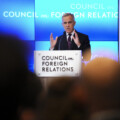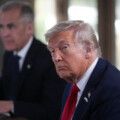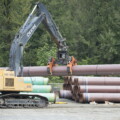Prime Minister Mark Carney’s announcement late last week that his government is abandoning retaliatory tariffs against the United States is good economics. The tariffs had little impact on the U.S. economy, and it’s far from obvious that they were imposing political costs on the Trump administration. In practice, they mostly hurt Canadian producers and consumers. Carney was right, therefore, to drop them.
But the politics may be another story. During the election campaign, Carney famously promised an “elbows up” approach to Washington. He vowed to stand firm against Trump’s protectionism. His platform even counted on $20 billion in tariff revenues to help offset a deficit-laden fiscal plan. The criticism that the prime minister has capitulated will likely resonate with a lot of voters, including many of the anti-Trump progressives who switched from the NDP to the Liberals to support him.
The biggest challenge, though, isn’t the predictable claims of flip-flopping. It’s the sense that Carney, who was supposed to be the steady hand, is adrift. It’s not clear that his government has a game plan for the negotiations or even what’s being negotiated. He looks far more scrambling than strategic.
Remember, we were told during the campaign that the government would immediately enter into post-election negotiations of a new trade and security agreement with the Trump administration. We were subsequently led to believe that it would be finalized in July and then later in August.
Now, as of Carney’s latest announcement, it’s not entirely clear that the plan is still to reach a deal with the White House. The new signal is that we may instead continue to live under the Canada-United States-Mexico Free Trade Agreement (CUSMA), which provides us with preferential access to the U.S. market compared to other countries and isn’t subject to review until next year.
That might be the best strategy for the government. But how is that any different than where we found ourselves months ago when the prime minister was talking about the end of the Canada-U.S. relationship as we knew it? Why is it now a good outcome for Canada?
It’s a bit crazy that we’re left trying to interpret how the prime minister is thinking about such a fundamental. His essential argument can be summed up as “trust me.”
The immediate cost comes in the form of economic uncertainty that looms over Canada’s economy as its own kind of tax. Businesses and investors don’t know what rules they’ll face in six or 12 months, and some are hedging against risk by moving production south, delaying capital plans, or cutting employment. Recent manufacturing job losses in Ontario are an early warning of what happens when Canada’s trade strategy is left adrift.
The Carney government’s ambiguity is a major source of the problem. If the strategy is to sit tight under CUSMA until the review period opens next year, then the prime minister should say so. If instead the plan is to keep trying for a new trade and security agreement with the Trump administration, then he should lay out the framework, the priorities, and the timeline. What’s becoming increasingly untenable is the notion that we’re supposed to just sit back and wait for Carney and his government to figure these things out.
The political risks of this drift are obvious. If the economy slows under the weight of uncertainty, Canadians will eventually start to doubt the prime minister’s steady hand. If so, it may transcend the Canada-U.S. issue and strike directly at Carney’s brand as a non-political technocrat.
We are already starting to see cracks. The decision to wade into the Air Canada flight attendant strike, for instance, put the government on the wrong side of its own progressive voters. If the prime minister can’t make the planes fly on time or fulfill his promise on the Canada-U.S. relationship, what’s the point? What’s the case for Carney?
That question is more than rhetorical. Carney’s political authority rests less on deep partisan loyalty than on the perception of competence and control. If that aura begins to fade, there isn’t much left holding his coalition together. Voters who lent him their support in April on the basis of technocratic reassurance may not hesitate to take it back if he looks like just another politician floundering through events.
That’s why this episode matters. Retaliatory tariffs may have been bad economics, but the way they’ve been dropped—without explanation, without a clear alternative, and without a broader framework for Canada’s relationship with the U.S.—risks eroding the basic foundation of Carney’s leadership. The steady hand is starting to look shaky.










